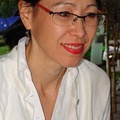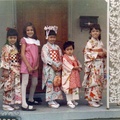Read part 1 >>
To get back to the prompt this forum is based on, I answer that I do see a parallelism between those expansions in an Asian American literature’s aesthetic/stylistic reach and that 1980s Presidential apology to Japanese Americans (although those $20,000 checks remain a bit of a thorn, and most pooled the money for monuments and programs that would keep the memory of those ten internment camps alive for future generations).
Those were the kinds of things that happened in my generation’s early adulthood.
Certainly, they were momentous revelations. But to me, on a more individual level now, an even more consequential shift came with comparatively little public fanfare the year 2000’s national census form had, for the first time, a possibility for persons of “mixed race” to check more than one box in defining themselves. So at last, at nearly thirty years of age, I could finally affirm before the government, before the law, that my identity contains more than one ethno-cultural root.
For atypical personal reasons, I had stumbled upon an earlier opportunity to rethink some of those identity categories and certainly cast healthy doubt on the mindset that inculcated such narrow, linear categories. This shifting of the terrain in my thinking was an indirect consequence, a sort of side effect, of my leaving the USA for an extended stay—to carry out academic work—in a South American city (first in 1988, then 1991, and again from 1992-94; I ultimately settled here in 1995 and have been living, teaching, and writing here since then).
In Buenos Aires, Argentina, particularly in the late 19th and early 20th centuries, immigration had been remarkably similar to the U.S. experience, but one senses that the modes of encounter in these new heterogeneities were quite different. Admittedly, neither scenario reflects the discursively touted “melting pot” ideal, but the Buenos Aires context seemed somehow to have been able to foster a viable co-habitation of multiple, convergent diversities that I was actually quite astonished by and, indeed, had probably yearned for in my home country.
To be sure, I do not mean to imply that this place does not also show symptoms of discrimination, racism, classism, sexism, etc. It does, in accord with the historical factors that inform power relations here. What I mean to point out—as part of the narrow, autobiographical point of view in this text—is that the patterns for encountering difference, even if antagonistic, were so radically different here from what I’d known at home that I was instantly (and with no little disorientation) liberated from the thought patterns I’d been steeped in since infancy.
I recall moments when it felt like I’d entered some sort of personal utopia. It was possible for anyone to ask “What are you?” with no sensation of threat or disdain or invasiveness of any kind. And everyone received the mouthful of an answer I had to give: “Oh, me? Well, I’m North American but raised in the distinctly non-anglo city of New Orleans, plus I’m Japanese on one side and German on the other side, though part of that stems from the Catholic minority and the other part ostensibly from an even smaller minority of Jews who’d converted to Lutheranism out of fear of anti-Semitism…so, um, that’s me, in a (mammoth) nutshell…”
Above and beyond the kind of positive reception my complex identity received, I quickly observed that, in the capital city of Buenos Aires at least, there was a remarkable ease with which people took their own heterogeneous identities. Indeed, everyone was comfortably (even eagerly) more than one ethnicity: Polish-Galician-Argentine, Basque-French-Indigenous-Argentine, Indigenous-Spanish-Argentine, Japanese-Argentine, Syrian-Argentine, Armenian-Argentine…Argentines, especially those from the large port that is the country’s capital, snickered with good cheer about being descended from no specific gene pool but rather from boats—a joke that clearly reflects the influence of great global migrations on their population’s ethno-cultural makeup. Even elected functionaries openly and willfully identified with both European and non-European roots. (That said, I did note more discrimination against the indigenous peoples, more so than against religious minorities, for example. Likewise, I observed more of a bias against those from neighboring Latin American countries, such as Bolivia and Paraguay, than against foreigners hailing from even distant and unfamiliar places like Nigeria or Ukraine or Malaysia.)
Overall, though, I was so positively struck by this unexpected expressiveness about ethnic heterogeneity that I sought to explore it more deeply, which I did both in my dissertation and in my fiction writing. In my first novel I purposefully constructed the principal characters with layered cultural backgrounds, in part to experiment with the resonances this might generate over the course of the narrative’s arc: they were born of “new world” countries but also marked by the codes inherent to Irish emigrants, French wanderers, or an accidentally displaced Japanese…And of course there was the tension surrounding what the term “American” could/should encompass as characters’ identities split (but never disintegrated) along a North-South divide.
When that book came out in Argentina, critics wrote readily about its treatment of multi-cultural identity as a central aspect, on both aesthetic and thematic levels. The focus was different in Spain, where the novel was released some six months later. There most seemed intrigued by the representation of mixed marriage in several characters’ lives. In an interview for a prominent Spanish newspaper, the journalist—whose sincere smile clearly showed she meant the question in a most positive way—wondered if I’d felt so free writing about interracial couples because I myself am the product of one. I was a bit puzzled, but chose to answer affirmatively, whereupon she congratulated me on my positive attitude and asked me—with all due respect and purely out of curiosity, she said—what it felt like to have an identity that was so “marvelously full of holes”?
And in that moment, I had a flash realization that the Americas—all of them, North to South—no matter how much discrimination and racism we still have to eradicate, comprise a much more evolved environment for handling multi-cultural experience and pluralist societies. I was instantly appreciative that I had grown up in a place like New Orleans, where all the identities got their time sooner or later on the dancefloor. There was always that inequitable public eye-time for being white and French, but everyone knew what it had meant in New Orleans to be black. Against that dark backdrop of a memory never hidden from view, we also had jazz and blues and even zydeco that manifested the strong, positive side of African American ways, and then Mardi Gras showcased Indian heritage too, with the Choctaw Indian heritage celebrated and memorialized, not to mention the tiny Japanese American community’s throwing its Boys’ Day picnics in City Park under the Dueling Oaks of slave-owning days. These prickly juxtapositions of course acquired even greater significance once we’d found out about the WWII internment camps and the government “recommendation” to Japanese Americans not to re-concentrate on the West Coast.
The point is, thanks to the environment and vibrant diversity of New Orleanian communities, each with its chances now and again to take a spin at center stage, I had already experienced viscerally (and in spite of dominant discourse to the contrary) a way of thinking that knew how to accommodate multi-faceted communities and do that continual inner negotiating that responsible multi-culturality demands.
*This article was first published in The Asian American Literary Review Spring 2012: Generations. The AALR has generously shared several of the forum responses, poetry, and prose with Discover Nikkei from this issue by David Mura, Richard Oyama, Velina Hasu Houston, Anna Kazumi Stahl, Amy Uyematsu, and Hiromi Itō (translated by Jeffrey Angles).
AALR is a not-for-profit literary arts organization. To learn more about it or purchase a subscription to the journal, visit online at www.asianamericanliteraryreview.org, or find them on Facebook.
© 2012 Anna Kazumi Stahl






